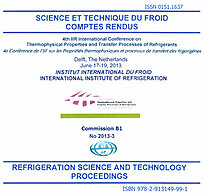
Résumé
Conventional modeling of condensers always assumes three zones: desuperheating, condensation and subcooling even condensation occurs in desuperheating zone at some conditions and that subcooling occurs during condensation. This paper discusses the actual situation and provides experimental validation of the hypothesis. The experimental results show heat transfer coefficients of CO2, R410A and R1234yf at mass fluxes 100 to 240 kg m-2s-1and reduced pressures from 68% to 100% in a horizontal smooth tube of 6.1 mm inner diameter. Data are compared to correlations proposed for other working fluids or other conditions. Results show much higher values of HTC than correlation proposed for single-phase turbulent flow in superheated zone. The occurrence of condensation in superheat zone is evident when tube wall temperature is below saturation temperature. The results suggest that simplified calculations of heat rejection in superheated zone significantly oversize the condenser. The semi-empirical correlation, which is here proposed as the combination of existing correlations for single-phase turbulent and saturated condensation, satisfactorily predicts the heat transfer coefficient of the superheat zone condensation.
Documents disponibles
Format PDF
Pages : 11 p.
Disponible
Prix public
20 €
Prix membre*
Gratuit
* meilleur tarif applicable selon le type d'adhésion (voir le détail des avantages des adhésions individuelles et collectives)
Détails
- Titre original : Refrigerant side heat transfer in condensers with round tubes.
- Identifiant de la fiche : 30008314
- Langues : Anglais
- Source : 4th IIR Conference on Thermophysical Properties and Transfer Processes of Refrigerants
- Date d'édition : 17/06/2013
Liens
Voir d'autres communications du même compte rendu (69)
Voir le compte rendu de la conférence
Indexation
-
Heat rejection in condensers: desuperheating, c...
- Auteurs : KONDOU C., HRNJAK P.
- Date : 16/07/2012
- Langues : Anglais
- Source : 2012 Purdue Conferences. 14th International Refrigeration and Air-Conditioning Conference at Purdue.
- Formats : PDF
Voir la fiche
-
R32 partial condensation inside a brazed plate ...
- Auteurs : MANCIN S., DEL COL D., ROSSETTO L.
- Date : 03/2013
- Langues : Anglais
- Source : International Journal of Refrigeration - Revue Internationale du Froid - vol. 36 - n. 2
- Formats : PDF
Voir la fiche
-
Superheated vapour condensation of R410A: a des...
- Auteurs : MANCIN S., DEL COL D., ROSSETTO L.
- Date : 21/08/2011
- Langues : Anglais
- Source : Proceedings of the 23rd IIR International Congress of Refrigeration: Prague, Czech Republic, August 21-26, 2011. Overarching theme: Refrigeration for Sustainable Development.
- Formats : PDF
Voir la fiche
-
Condensation in presence of superheated vapor f...
- Auteurs : KONDOU C., HRNJAK P.
- Date : 21/08/2011
- Langues : Anglais
- Source : Proceedings of the 23rd IIR International Congress of Refrigeration: Prague, Czech Republic, August 21-26, 2011. Overarching theme: Refrigeration for Sustainable Development.
- Formats : PDF
Voir la fiche
-
Effect of microfins on heat rejection in desupe...
- Auteurs : HRNJAK P., KONDOU C.
- Date : 16/07/2012
- Langues : Anglais
- Source : 2012 Purdue Conferences. 14th International Refrigeration and Air-Conditioning Conference at Purdue.
- Formats : PDF
Voir la fiche
